Venice: Jan Fabre at Palazzo Balbi Valier with the man who measures clouds
On the occasion of the 58th. International Art Exhibition of the Venice Biennale, the great artist and author Jan Fabre (Antwerp, 1958) returns to the lagoon with the presentation of a special public art project. Installed inside the Garden of Palazzo Balbi Valier and visible from the Grand Canal, the gold-leaf monumental sculpture The Man who Measures the Clouds (Monument to the Measure of the Immeasurable), stands nine meters high.
The project is a collaboration of Angelos (Antwerp, Belgium), EdM Productions and Foundation Linda and Guy Pieters (Saint-Tropez, France) and is curated by Joanna De Vos . Open to the public from Monday, May 6, it will remain until the end of the 2019 Art Biennale on Sunday, November 24.
The Man Who Measures the Clouds (Monument to the Measure of the Immeasurable) is an unprecedented and unique monumental work finished in gold leaf. Conceived specifically for Venice, it harks back to a deep connection with this city established over the past decades. Leaning over the arch leading to the Garden of Palazzo Balbi Valier from the Grand Canal, this imposing golden man reflects not only the drift of the artist and humanity, but also the historical significance and values of this mythical floating city.
The title of the sculpture refers to the story of ornithologist Robert Stroud, who at the time of his release from Alcatraz had stated that from then on he would devote himself solely to “measuring clouds,” and contains an invitation to reflect on the role of the artist in society. The work lends itself to be read as a "metaphor of the artist who seeks to capture the impossible through his work," to quote Fabre himself, taking inspiration from the philosopher Protagoras’ assertion “Man is the measure of all things, of those that are for what they are, and of those that are not for what they are not.” For the Greeks, man is the unit of measurement of the mutual relationship between objects, and similarly, Fabre’s man stands as the measure of all things, in homage to the greatness of the human imagination.
From the Greeks to the present, man is attracted to monumentality: bigger, more visible, and more powerful. The scale and size of Fabre’s sculpture, along with his outdoor installation in Venice, have a profound impact on its meaning and how it is experienced. Does Jan Fabre use the enormous height of this sculpture to make physically visible the extent of human effort? Man always wants to measure himself and loves to excel; it is impossible to overlook these facts in a historic city like Venice.
The subject is a man in contemporary clothing who, stretching his arms to the sky, stands on a library ladder, holding a surveyor’s ruler with both hands, in the gesture of measuring celestial objects. The figure appears to represent Fabre himself, but is in fact modeled on the body of his younger brother, Emiel Fabre, who died at an early age; the resemblance between the two brothers was irrefutable. The longitudinal thrust of the body meets the decisive horizontality of the splint it supports, achieving a culmination where a temporary reconciliation between horizontal tension and verticality occurs. The compositional balance echoes the perfection to which man aspires, to such an extent that he sets himself as the unit of measure of all creation, to push himself higher and higher, aiming for the sky with his monumental works of art and magnificent architecture that are tangible witnesses to his desire for affirmation.
The silicon bronze work is completed with a gold leaf covering, making it a kind of contemporary idol/icon. The colossal size of the sculpture and its golden radiance restore magnificence to the human endeavor. The use of gold in the Venetian context also brings to mind multiple connections with the history of the city and the men who inhabited it and made it a trading power over the centuries. Indeed, it was in Venice, in 1284, that the first gold coin was minted, which remained the benchmark for all European currencies for 600 years. Today, it is in Venice that the ancient workmanship of gold leaf survives, within the only existing workshop in Europe still capable of using the original 18th-century techniques.
Who, then, is this measurer of the unknown who deludes himself into believing he can comprehend the greatness of the unmeasurable? Jan Fabre leaves the viewer with an unresolved doubt, a “creative thought” that prompts one to look upward to note the indefiniteness of the sky above Venice and of human perspective itself. Jan Fabre thus offers the public a monument to the measurement of the immeasurable and challenges the viewer to rethink the meaning of proportion.
The project will be accompanied by a publication, with text by Joanna de Vos, in a limited edition of 300 copies, 200 of which are numbered and signed by Jan Fabre and Joanna de Vos; graphic design by Aline Billiet.
Source: release
 |
| Venice: Jan Fabre at Palazzo Balbi Valier with the man who measures clouds |
Warning: the translation into English of the original Italian article was created using automatic tools. We undertake to review all articles, but we do not guarantee the total absence of inaccuracies in the translation due to the program. You can find the original by clicking on the ITA button. If you find any mistake,please contact us.




























